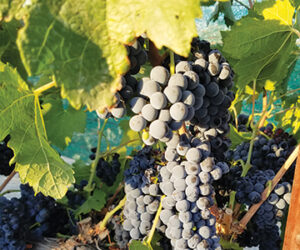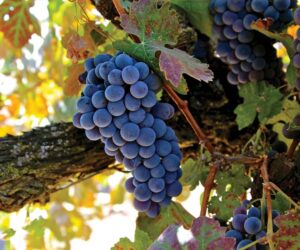
Picture this scene: A crisp fall day, sitting out on the patio relaxing as you reflect on another year’s harvest. Muscles tired from some busy days getting grapes into the winery, but a sense of accomplishment knowing that all of your fermentations are moving along. As you think about the months and years ahead for some of the wines to reach maturity you sip a cool glass of a very young wine made from grapes harvested just a week earlier. Enjoying the day, you may drink a few glasses and then go on with your afternoon without the buzz that would ensue if drinking your normal
homemade vinos.
This description is a popular occurrence during a central European autumn, but the drink in question isn’t commonly made or well known outside of the region.
The drink is called Federweißer (feh-dehr-vy-sehr), or Federweisser, in Germany, which comes from the fact that the beverage’s bubbles dance around like feathers (Federn). Essentially, it is juice from white wine grapes that is allowed to ferment for a day or three before the fermentation is slowed by cool temperatures. Since fermentation is not completely stopped, it is intended to be consumed extremely fresh (or else it will continue fermenting) and the cap on the bottle must remain loose to allow CO2 to escape. These qualities mean that it cannot viably be exported, the bottles must be kept upright, and they must stay chilled. Federweisser is popular in countries such as Germany, Austria, the Czech Republic, and Slovakia where it is commonly sold for a very limited timeframe in the autumn. However, it is largely unheard of outside of central Europe.
I remember first trying this low-alcohol wine back in 2007 on a study abroad semester in the Czech Republic and being pleasantly surprised by its unique flavor. Later, I moved to Germany, where September heralds the arrival of its very brief season of consumption.
Outside of federweisser, other names for this drink within Germany and Austria are Bitzler and Sturm, and there is also burčák (Czech), burčiak (Slovak), and Sauser (Swiss German). It also has a red wine version, called Federroter, which is also beloved by many in central Europe, but admittedly the white wine version is the more popular of the two.
Since federweisser is unfiltered, it has a murky, almost cloudy appearance similar to fresh-pressed apple juice. Its taste is sweet, light, and refreshing. It can be a bit dangerous as it doesn’t taste very alcoholic and has a sweetness to it as much of the grapes’ sugar has not been fermented, so don’t get carried away! Typically, federweisser starts at around 4% ABV, though each person who makes it has the ability to slow fermentation at their discretion, so ABVs vary and even increase if not consumed the same day.
When refrigeration inside trucks and other forms of cooled transportation came along, it made possible for federweisser to be sold in neighbouring regions outside of wine-growing areas. Therefore, people who live in places like Hamburg, Germany, or Innsbruck, Austria, where winegrapes aren’t grown still have access during the season to purchase federweisser from grocery stores and specialty wine shops. Though, federweisser is most often bought directly from small-scale winery tasting rooms, at farmer’s markets, and in countries including the Czech Republic and Slovakia, you can often fill your bottle from a barrel or get it in plastic bottles at roadside kiosks in autumn.
Choosing Grapes
Highly aromatic varieties are the preference, which means varieties like Moravian Muscat and Müller-Thurgau are commonly used in the Czech Republic, while Müller-Thurgau, Solaris, and Ortega are popular choices in Germany. While some of these varieties are grown elsewhere, or imported to markets in North America, similar varieties such as Riesling, Gewürztraminer, or even Sauvignon Blanc may be good choices to try as well. What you are going for is a balance of sugar, alcohol, and acids. Generally, wineries releasing federweisser will do so with grapes that aren’t the best quality, and therefore wouldn’t make the best table wines. In addition to being aromatic, another reason many wineries in central Europe use varieties like Solaris or Moravian Muscat is they aren’t necessarily the varieties of choice for high-end wines, and they also tend to be the earliest to ripen. Some countries have laws that federweisser (or whatever name it goes by there) must use local grape varieties.
In theory, federweisser can be made by winemakers at home using whatever wine grapes are available to them. Experimenting with different varieties to find what you like may be the best approach.
Ideally, for making federweisser, the grapes should be harvested in the early morning when the temperatures are cool to help protect the heat-sensitive substances in the grapes.
More aromatic red varieties are also most common for making federroter. Varieties I’ve heard used that are common in central Europe include Blaufränkisch (Lemberger), St. Laurent, Blauer Portugieser, and Dornfelder. For producing a rosé style, it is most common to use the blanc de noir approach, according to Vojtěch Válka of Vinařství Válka winery in the Czech Republic, where “the skins sit in the juice for a short time to extract some color and light tannins,” between destemming the grapes and pressing the juice.

Federweier Production
When to cool the fermentation is the biggest decision winemakers have beyond what variety to use, though other decisions include whether to pitch a cultured yeast vs. relying on natural inoculation, and whether to chaptalize with sugar. The grapes’ sugar content for federweisser should be “between 190–230 g/L (19–23 °Brix), and the ideal pH is around 3.1–3.6,” says Válka. To get there, some grapes may require the addition of sugar after crushing, though this technique isn’t very common. In theory, federweissercan achieve up to 10% alcohol content if being brought to market and sold in the next two days, though much lower alcohol levels are more traditional. Occasionally, when making federweisser, if the grapes are not harvested early and continue picking up sugar on the vine (25+ °Brix) a very small amount of water is added to dilute it slightly. But generally speaking, as in the standard winemaking process, water is not added to federweisser.
Admittedly, there are a number of challenges in giving concrete instructions for home winemakers in North America. Since federweisser is simply a step in the process of making wine or seen as a byproduct of larger-scale production, it has never gotten much historic attention when it comes to the process. Some of the challenges include the general lack of English-language instructions for the process. Further, the fact that it’s often produced by wineries or families who have been making it for generations and don’t necessarily want to share their “secret recipe” limits the information available on the process. (Trust me, this author reached out to more than 10 wineries who produce federweisser, and Válka was the only one who would share advice.)
Válka offers a federweisser for sale around harvest each year and was kind enough to share his longtime approach, which follows:
What you’ll need:
Ripe white winegrapes
Grape press, destemmer
Glass, food-grade plastic, or stainless steel vessel
Wine yeast such as Lalvin 71B or Lalvin ICV-D47
Airlock
pH meter and refractometer
Temperature control
Step by step
Destem and press the grapes.
Transfer the juice into a fermentation vessel.
Rehydrate and activate the wine yeast according to the manufacturer instructions, and pitch it into the full batch.
Attach a fermentation lock and, if able, keep the fermenter in a warm area to speed up the start of fermentation (around 77–86 °F/25–30 °C for a short time).
Once fermentation starts, cool the mixture down to control the speed of fermentation. The ideal fermentation temperature for federweisser is 54–61 °F (12–16 °C).
If the fermentation process starts moving too quickly, lower the temperature — if need be, the batch can be placed in a freezer to rapidly halt the procedure. Contrarily, if fermentation occurs too slowly, warm the beverage slightly.
When the hydrometer reading for the federweisser shows a drop of about 6 °Brix (which would lead to a beverage of about 4% ABV), it can be consumed immediately or chilled for a further day or two at most. There is some flexibility with Brix, and if you would like to ferment it less or more that is all up to you.
Chef Andreas Luck has a video tutorial on making federweisser simultaneously with federroter. With his permission, the following recipe is primarily based on his tutorial instructions with additional tips and feedback from other home winemaking recipes from central European devotees of the beverage.
What you’ll need:
Ripe grapes such as Riesling, Müller-Thurgau, or Bacchus Wine yeast such as Lalvin 71B or Lalvin ICV-D47
1-gallon (3.8-L) fermenter
Wine press
Airlock
Step by step
Destem and press the grapes.
Fill a carafe or container up to two-thirds full with the pressed juice.
Rehydrate yeast and add it to the must (1 gram of yeast per 11 lbs./5 kg of grapes prior to pressing).
Put an airlock atop the carafe or bottle, and set the liquid to the side. During the initial 24 hours of the fermentation process, the mixture can be stored at room temperature. After approximately 24 hours, but possibly a little earlier, if the yeast has begun to settle it is time for a quick and easy filtration through a muslin or cheesecloth. This will not strain out the yeast, but it will strain out the gross lees.
When the hydrometer reading for the federweisser shows a drop of about 6 °Brix (which would lead to a beverage of about 4% ABV), it can be chilled in the refrigerator and should be consumed within a day or two. If desired, one may decide to add 10-20 grams of sugar per quart/liter of federweisser before consumption if the taste is a bit too astringent or bitter.
Tips and advice:
When pouring the juice into the fermenter of choice, it is important not to fill up the container completely, as there will be a bit of expansion during the fermentation process.
It is important to remember that cooling will slow fermentation, but it will not stop it. For this reason, never store the drink in an airtight container, which could lead to potential explosions and a rather messy situation! This is also why in many locales or roadside stands the beverage is sold in plastic bottles to prevent the glass from potentially exploding and causing damage. Empty plastic soda or juice bottles work great. Remember, the longer it is stored, the more alcohol it will contain and the flavor will change as well.
It is normal for some sediment to occur inside of the storage vessel. This does not mean that something has gone wrong with the process.
Traditionally, federweisser is enjoyed with foods such as Flammkuchen (a thin flatbread covered with toppings like creme fraiche and cheese), Zwiebelkuchen (onion flatbread), roast chicken, and various cheeses. It also pairs well with mushroom dishes and Speck (German pork belly bacon).







